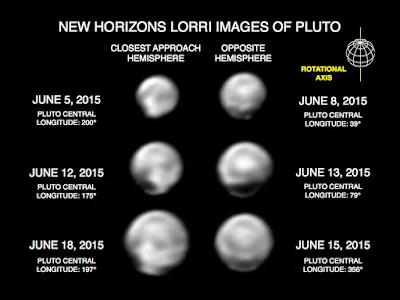These images taken by New Horizons’ LORRI
long-range camera resolve some surface features of Pluto’s largest moon Charon,
including an odd dark patch near one of its poles. Credit: NASA/Johns Hopkins
University Applied Physics Laboratory/Southwest Research Institute
85 χρόνια μετά την
ανακάλυψη του Πλούτωνα από τον αστρονόμο Clyde
Tombaugh, στις 14 Ιουλίου 2015 ένα διαστημικό σκάφος της ΝΑΣΑ, το New
Horizons, θα περάσει πολύ κοντά από το σύστημα του Πλούτωνα με τους 5
δορυφόρους του.
These images, taken by New Horizons' Long
Range Reconnaissance Imager (LORRI), show numerous large-scale features on
Pluto's surface. Credit: NASA/Johns Hopkins University Applied Physics
Laboratory/Southwest Research Institute
Ήδη φτάνουν πολλές
εικόνες του Πλούτωνα και των δορυφόρων του. Σε μια από αυτές φαίνεται μια
μυστηριώδης σκοτεινή κηλίδα σε έναν από του πόλους τους Χάροντα. Οι αστρονόμοι
βλέπουν συχνά φωτεινές κηλίδες στην επιφάνεια ενός πλανήτη εξαιτίας του πάγου,
όχι όμως σκοτεινές κηλίδες.
"Who ordered that?" asked
Alan Stern of the Southwest Research Institute and leader of the New Horizons
mission, echoing a famous phrase by which the physicist Isidor Rabi once
responded to the discovery of a new unexpected subatomic particle. Images of Pluto’s largest moon Charon taken by
New Horizon’s long-range camera suggest that the Texas-size moon has a broad,
dark, region at its pole. Credit: NASA
«Ποιος την παρήγγειλε
αυτή;» αναρωτήθηκε Alan Stern που ηγείται της αποστολής New Horizons,
επαναλαμβάνοντας την περίφημη ρήση του φυσικού Isidor Rabi όταν πριν από
δεκαετίες ανακαλύφθηκε απρόσμενα ακόμη ένα σωματίδιο, το μιόνιο.
Πηγή: nytimes.com




Δεν υπάρχουν σχόλια:
Δημοσίευση σχολίου